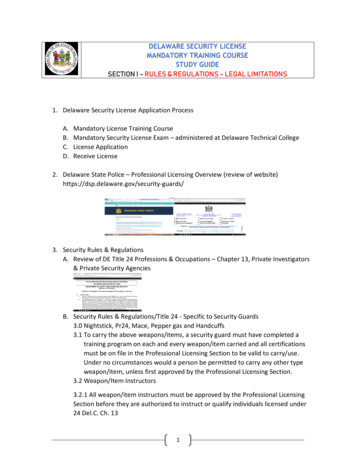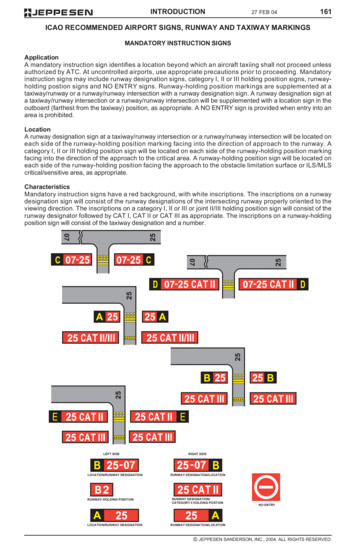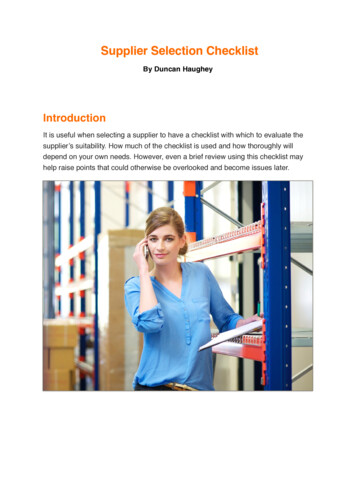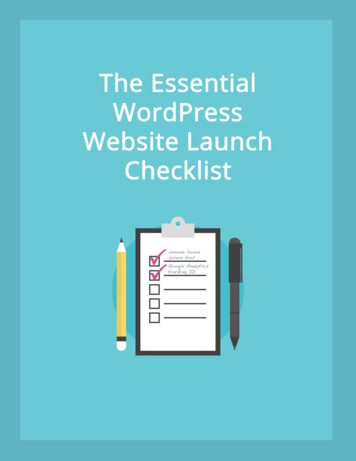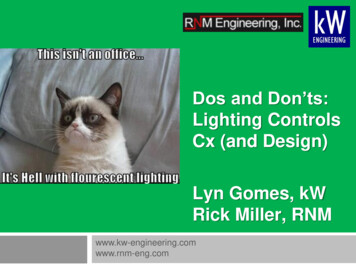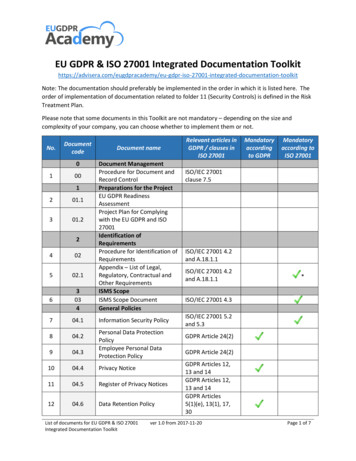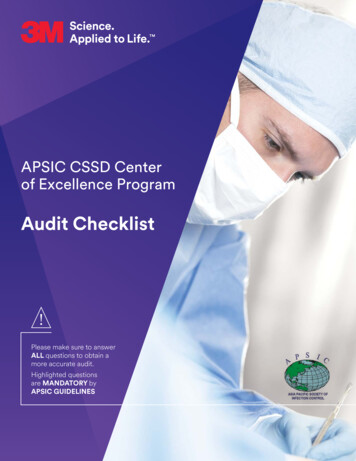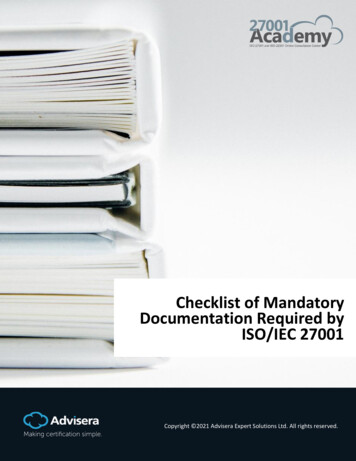
Transcription
Checklist of Mandatory DocumentationRequired by ISO 9001:2015WHITE PAPER
Table of ContentsBASIC OVERVIEW . 31. Which documents and records are required? . 32. Commonly used non-mandatory documents . 53. How to structure documents and records . 6Copyright 2017 Advisera Expert Solutions Ltd. All rights reserved.2
BASIC OVERVIEWIt is easy to become overwhelmed with documentation in the belief that every single process that is inplace in an organization must be documented, without realizing that this is not necessary to meet therequirements of the ISO 9001 standard. The 2015 revision of the standard become more liberal regardingdocumentation requirements, meaning that there are no longer six mandatory procedures as in theprevious 2008 version of the standard. ISO 9001 also identifies many records that need to be maintained,which are generated by the processes of the Quality Management System. Below is discussed whichdocuments and records are mandatory, and which are optional.1. Which documents and records arerequired?Required DocumentsStatutory and Regulatory (Legal) RequirementsISO 9001:2015 Clause1External and Internal Issues4.1Needs and Expectations of Interested Parties4.2Scope of the Quality Management System4.3Quality Policy5.2Roles, Responsibilities and Authorities5.3Risk Assessment and Opportunities6.1Quality Objectives and Plans for Achieving them6.2Organization Knowledge (Competency Matrix)Communication Matrix (Optional)7.1.6, 7.2, 7.37.43
Mandatory RecordsRecord of Maintenance and Calibration of Monitoring andMeasuring EquipmentCompetence RecordsISO 9001:2015 Clause7.1.5.17.2Product / Service Requirements Review Record8.2.3.2Record of New Requirements for Product or Service8.2.3.2Design and Development Inputs Record8.3.3Record of Design and Development Controls8.3.4Design and Development Outputs Record8.3.5Record of Design and Development Changes8.3.6Record of Evaluation of External Provider (Supplier)8.4.1Record of Product / Service Characteristics8.5.1Record of Changes on Customer’s Property8.5.3Record of Changes in Production / Service Provision8.5.6Evidence of Product / Service ConformityRecord of Nonconformity8.68.7.2, 10.2.2Monitoring Performance Information9.1.1Internal Audit Program and Results9.2.2Management Review ResultsNonconformities and Corrective Action9.310.2.2These are required documents and records that are required to be maintained for the ISO 9001 QualityManagement System, but you should also maintain any other records that you have identified asnecessary to ensure your management system can function, be maintained, and improve over time.4
2. Commonly used non-mandatoryProcedureNon-Mandatory ProceduresDetermining Context of the Organization and Interested PartiesProcedure for Addressing Risks and OpportunitiesProcedure for determining Competence, Training and AwarenessISO 9001 Clause4.1, 4.26.17.2, 7.3Procedure for Control of Documents and Records7.5Procedure for Managing Sales8.2Procedure for Design and Development8.3Procedure for Control of Externally Provided Processes,Products and Services (outsourced processes)Procedure for Production and Service Provision8.4.18.5Warehousing Procedure8.5.4Procedure for Measuring Customer Satisfaction9.1.2Procedure for Internal Audit9.2Procedure for Management Review9.3Procedure for Nonconformity and Corrective Action10.2While ISO 9001 does not require that you document all of the procedures, there are several processesthat are mandatory to be established in order to generate the required records that are outlined in thefirst section. Remember these processes and procedures are not required to be documented; however,many companies choose to do so. One rule of thumb when deciding if you want to document a processis this: if there is a chance that the process won’t be carried out as planned, then you should documentit. In many cases this is the best way to ensure that your Quality Management System is reliablyimplemented.5
3. How to structure documents andrecordsDetermining Context of the Organization and Interested PartiesThis is a new requirement of the standard that can bring some ambiguities, and it is a good idea todocument the process of determining the context and identifying interested parties and theirexpectations, since it is being done for the first time. This document should contain all internal andexternal issues to be considered, as well as the process and responsibilities for identification ofinterested parties and their needs and expectations. Procedure for Determining Context of theOrganization and Interested Parties can be of great help in implementation of these new requirements.QMS ScopeThis document is usually rather short, and written at the beginning of the ISO 9001 implementation. Itspurpose is to define the boundaries of the QMS and to determine to which parts of the organization theQMS applies. Normally, it is a standalone document called Scope of the QMS, although it can be mergedinto a Quality Manual.Quality PolicyThe Quality Policy is intended to be a company’s documented intention to comply with appropriaterequirements, increase customer satisfaction, and continually improve. The policy is the focus for thecompany to work toward and should readily convey the goal of the organization. It is a standalonedocument, but is often documented in a Quality Manual and sometimes posted throughout theorganization as a way of communicating to all employees, since it is important that every employeeunderstand how the policy relates to his or her job. For more information, see How to Write a GoodQuality Policy.Risks and Opportunities that need to be addressedThis is a new requirement that introduces significant changes to the QMS. According to the new version,the risks and opportunities regarding the QMS must be identified and addressed, but there is norequirement to use any methodology or write a procedure. The process of addressing risks andopportunities includes consideration of internal and external issues relevant to the QMS, interestedparties, and scope of the QMS. Considering the importance of this new requirement and the fact that it6
introduces a completely new process into the organization, it is recommended that it be documented inthe form of a procedure.Quality Objectives and Plans for Achieving ThemThe requirements regarding setting the quality objectives remained as they were in the previous versionof the standard; they still need to be measurable and timed. However, the standard now requires plansfor achieving the objectives, meaning that the organization will have to assign responsibilities anddedicate resources for achieving the objectives. These requirements can be met in separate documents,but it is much easier to create a Quality Objectives document and fulfill all the above-mentionedrequirements.Competence, Training and Awareness recordsIntroducing quality management into an organization often requires additional training of relevantemployees. Describing the process of managing human resources by documenting a procedure thatdefines identification of training needs, training planning, conducting and evaluation of trainingeffectiveness, as well as assigning responsibilities for this, is the best way to ensure that the requirementsare met. Although it is not a requirement of the standard, good practice shows that the Procedure forCompetence, Training and Awareness can be of great help to an organization. The standard explicitlyrequires only the evidence of competence, and that is the Training Record.Procedure for Control of Documents and RecordsManaging documented information is defined by many requirements within clause 7.5 in the standard.Activities of approval, update, managing changes, and ensuring that the relevant version of the documentis in use are best to be defined in a documented procedure.The company must also define rules to maintain its records that show the QMS is implemented andmaintained, including how they identify, store, and protect the records so that they can be retrieved asnecessary, for the correct amount of time, and destroyed when no longer needed but not before. If youneed more information, see New approach to document and record control in ISO 9001:2015.7
Sales procedureAlthough it is not a mandatory procedure, the standard prescribes numerous rules regardingcommunication with customers, determining requirements related to product and services, andactivities regarding review of these requirements. Good practice shows that the best way to conformto all these requirements is to document them, together with responsibilities. The only mandatorydocumented information here are the records of reviewing requirements related to product andservice, as well as information about new requirements for products and services.Procedure for Design and DevelopmentRequirements regarding the design and development process are among the most demanding in thestandard. Every step of the design and development process needs to be documented in the form of arecord, from design and development inputs, controls, and outputs, to changes in design anddevelopment. Considering all the requirements regarding the design and development process, it isbest to document the Procedure for Design and Development and define all mandatory records thatshould accompany the procedure.Procedure for control of externally provided processes, products and services (outsourced processes)Creators of the standard decided to use this rather robust formulation of something that is basicallythe Procedure for Purchasing and Evaluation of Suppliers. Although the purchasing process doesn’thave to be documented, the standard requires companies to establish control over its externallyprovided processes, products, and services. The standard does require the criteria for evaluation,selection, monitoring, and re-evaluation of the suppliers to be documented, and the best way to do it isthrough the procedure.Procedure for production and service provisionThe standard requires production and service provision processes to be under control in terms ofavailability of necessary documented information about product or service characteristics, intendedresults, availability of needed resources, monitoring and measurement activities, etc. This rathercomplex process will hardly achieve the intended outcomes without clearly defined rules documentedin the Procedure for Production and Service Provision.Warehousing procedureThe importance of this procedure will vary depending on the type of business performed, but therequirement for product preservation is one of the most crucial ones in the way of the product orservice toward the end user. In cases when the storage conditions can have great influence on theproduct quality, rules for preservation of the product during storage should be documented in thisprocedure.
Monitoring performance informationThe new version of the standard emphasizes the importance of measuring and evaluation of QMSperformance. The organization needs to determine what should be monitored, how, and when. Thisdoesn’t have to be in one document, meaning that necessary monitoring and measuring is usuallyincluded in related process procedures. But, it is good to have an overview of key performanceindicators and their status in the form of a Matrix of Key Performance Indicators.Internal auditHow do you audit your Quality Management System to make sure that it is performing as planned andis effective? Who is responsible for planning and carrying out the audits? How do you report theresults, and what records are kept? How do you follow up on corrective actions noted in audits? Learnmore in this article about the Five Main Steps in ISO 9001 Internal Audit. You must also keep recordsof these activities to show QMS conformance and improvement.Management reviewManagement review as a process hasn’t suffered any changes in the new ISO 9001:2015 revision interms of how and how often it should be conducted. However, the mandatory inputs and outputs ofthe management review have changed. It is now required for the top management to review internaland external issues relevant to the QMS, as well as the effectiveness of actions taken to address risksand opportunities. As a result of the management review, there should be decisions regardingopportunities for improvement of the QMS, need for changes of the system, and resources needed.The best way to keep track of what needs to be reviewed and the expected results of themanagement review is to document the Procedure for Management Review.Nonconformity and corrective actionWhat actions are in place, and who is responsible for making sure that a nonconformity is addressed?How do you ensure that corrections are made, and what records are kept of the process? Find outmore here: Understanding dispositions for ISO 9001 nonconforming product. How do you reviewnonconformities, determine causes, and evaluate the need for actions to correct them? How do youimplement the necessary actions, review that the actions were effective, and keep records of theactions taken? With the Quality Management System, you will find that you have non-conformancesoccur within your processes that you will need to correct; and when you investigate the root cause ofthese problems, you will have corrective actions taken. You will also need to keep records of theseactivities to show improvement. Learn how to do this with Seven Steps for Corrective and PreventiveActions to support Continual Improvement.
previous 2008 version of the standard. ISO 9001 also identifies many records that need to be maintained, which are generated by the processes of the Quality Management System. Below is discussed which documents and records are mandatory, and which are optional. 1. Which documents and records are required? Required Documents ISO 9001:2015 Clause


